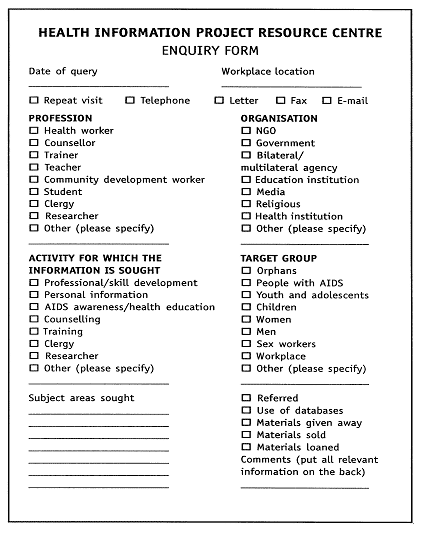7.12 Information packs
Information packs are an economical way of providing information
about a particular subject area to users who cannot visit the
resource centre.
Information packs usually take the form of folders (cardboard
wallets) or envelopes containing a variety of materials, such
as articles from newsletters and journals, photocopied pages
from books, factsheets, posters, leaflets, materials developed
within the organisation, or materials distributed free by other
organisations working in the same subject area.
When developing an information pack as a resource to distribute
to users, it is important to obtain permission from the publisher
to include an item (text or illustrations) in a pack, unless
the publisher has indicated that this is not necessary. The
publisher will want to know the purpose of the pack and its
target audience, the number of copies to be produced, and any
charges to users (for example, to cover the cost of photocopying
and distribution, or to make a profit to help the resource centre).
If producing a single pack to respond to an individual enquiry,
it is not necessary to request permission from the publisher,
provided copyright laws are followed (see
Section 7.6: Photocopying).
Before any information packs are prepared, it is important
to be sure that the right materials have been selected to go
in them. This can be done by discussing the contents of a proposed
information pack with members of the resource centre advisory
committee, and or other key users. It can be useful to include
a short evaluation form in the pack for users to complete and
return. This can point to ways of improving future information
packs.
Information packs should always include a contents list that
provides details of the original source of each item (such as
a book or periodical title, publisher and year published).
An information pack is not a static thing. It will need to
be updated by adding new materials, as well as or instead of
existing materials. It is important to keep the master photocopy
of each of the materials included in an information pack, to
ensure that each copy is of the same quality, and that time
is not wasted looking for the original material each time a
copy needs to be made. Alternatively, if the resource centre
has a bibliographic database, codes could be added to the records
of new materials to indicate that they are suitable for inclusion
in the information pack.

Sample enquiries form
next: 7.13 Newsletters
top of page

